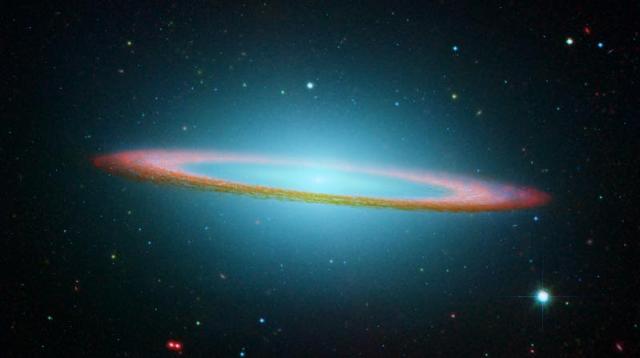|

by Stephen Smith
May 12, 2008
from
Thunderbolts Website

Combined visible and infrared images of M104.
Infrared: NASA/JPL-Caltech/R. Kennicutt (University of Arizona), and
the SINGS Team
Visible: Hubble Space Telescope/Hubble Heritage Team
An “accretion disk” of dark dust and gas
surrounds this mighty collection of 400 billion stars. It is
electrical energy that powers and shapes these features.
M104 is probably the most
spectacular representation of “lens-shaped” galaxies that has been
produced by any telescope. Originally discovered by Pierre Méchain
in 1781 and then added to Messier’s famous catalog in the same year,
M104 remains a centerpiece of scientific investigation after more
than 300 years.
William Herschel independently
rediscovered M104 in 1784.
The Sombrero Galaxy is actually much larger than what can be
seen in the image above.
The galaxy is surrounded by a halo of
stars, dust and gas that indicate it may actually be an
elliptical galaxy that contains a
more robust interior configuration. Shorter time exposures reveal
distinct spiral arms radiating from the center and it is referred to
as a “spiral galaxy” by astronomers. M104 is surrounded by globular
clusters in the hundreds – a much richer population than our own
Milky Way or most other observed galactic bulges.
Astronomers have long maintained that galaxies are clouds of
hydrogen gas and intergalactic dust that have been compressed by
gravity until they coalesce into glowing thermonuclear fires. In
the recent past, the community has also proposed that the centers of
most galaxies contain black holes of unbelievable magnitude.
It is the activity of these
“gravitational point sources” – some as powerful as the gravity
field from 200 million stellar masses – that causes the galaxies to
spin, globular clusters to spawn, tremendous jets of gamma and
x-rays that span thousands of light-years to appear, and (among many
other features) “radio lobes” that are larger than the galaxy out of
which they discharge.
As most conventional researchers have noted, the fact that galaxies
and other celestial objects spin is attributed to the early
formation of their structure. A galactic embryo is said to possess
an angular momentum that increases as it begins to fall into its own
gravity well. In an oft-repeated illustration of how this occurs, we
can visualize an ice-skater doing a pirouette.
As the skater’s arms are drawn in closer
to the body, the spin-rate increases. Thus, as the galaxy begins to
contract the acceleration of the cloud increases, causing spiral
arms to form, a disk of material to begin surrounding the central
nucleus and globules from eddy-currents within the gases to condense
into stars. This all occurs because the spin in the cloud overcomes
the gravitational attraction through centrifugal force, throwing
material outward like a drop of paint on a spinning platter.
The
Electric Universe model does not
permit the condensation of galaxies from cold, inert hydrogen and
specks of zircon no bigger than an molecule.
So, what are
galaxies?
In 1981, Hannes Alfvén presented his hypothesis for “electric
galaxies”. He said that galaxies are actually very much like a
device invented by Michael Faraday, the homopolar motor. A homopolar
motor is driven by magnetic fields induced in a circular aluminum
plate or some other sufficiently conductive metal. The metal plate
is placed between the poles of an electromagnet that causes it to
spin at a steady rate proportional to the input current. The meter
attached to the wall in most backyards that determines monthly
electric bills is a homopolar motor.
So, what does this mean for galactic
genesis and evolution?
Galaxies exist within an inconceivably large filamentary
circuit of electricity that flows
through the cosmos from beginning to end. There is no way to know
where this current flow rises, or to what electrode it is attracted,
but we see the effects of its electromagnetic fields in the
magnetism and synchrotron radiation that permeate space.
That electricity organizes itself within
fields of plasma that are sometimes larger than galaxy clusters. The
plasma is composed of neutral atoms, but a small fraction of
electrons, protons and other charged particles are also present.
Those particles, and the charge-neutral ones they sweep along with
them, are driven by the larger electromagnetic field to form
“pinches” of matter.
As many of the
plasma pioneers have pointed-out,
plasma isolates its charges within “double-layers” folded inside
helical tubes called
Birkeland currents. As the currents
propagate, their mutual attraction causes them to “pinch” into
tighter and tighter helices. In Electric Universe theory, the
clusters that formed in the pinch zones of Birkeland current strands
around M104 show it to be extremely active.
The large number of clusters and a
distinct “homopolar disk” are a sign of electrical activity.
Filaments exist everywhere: from sparks that leap from doorknob to
fingertip after walking across a nylon carpet, to flashes of
lightning, to collimated “jets” of x-rays that erupt from the axes
of galaxies (and stars), to the cosmic “strings” of superclusters
that make-up the large-scale structure of the universe. To elicit
such displays the forces of gravity and inertia alone appear to be
insufficient.
The primal electrical energy source is orders of magnitude more
powerful than gravity.
The “plasma
ropes” that comprise Birkeland currents attract one
another over distance in a linear relationship, rather than through
the “square-of-the-distance” proportions of gravity. That makes
Birkeland currents the most powerful long-range attractors (and also
short-range repulsors) in the universe.
Electric currents flowing through
dusty plasma beget and sustain the galaxies.
|

